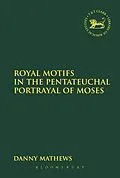Moses is portrayed through the use of royal motifs, such as his abandonment at birth, flight from Pharaoh, portrayal as a shepherd, as a semi-divine figure, temple builder, military general, and lawgiver. These well-known motifs that have been typically used to depict four famous rulers in the ancient Near East, Hammurabi, Esarhaddon, Nabonidus, and Cyrus, have been adapted by the authors of the Pentateuch to affirm Moses as a more ancient leader, whose work has resulted in the constitution of the community of Israel. As a result, Israel's identity and enduring existence rest upon the authority and legacy of Moses.
Autorentext
Inhalt
Chapter One: "Who am I?": Unraveling the Mystery of Moses
I. Introduction
II. Moses in Classical Sources
A. The Portrayal of Moses in Early Hellenistic Sources
B. Philo's Portrait of Moses
C. Josephus' Portrayal of Moses
D. Conclusion
III. Moses in Modern Critical Scholarship
A. Modernizing Moses
B. Moses and Methodology
C. Recent Studies of Moses
IV. Conclusion
Chapter Two: Royal Motifs in the Pentateuchal Portrayal of Moses: An Overview
I. Introduction
II. Survey of the Portrayal of Moses in thePentateuch
A. The Birth and Abandonment of Moses
B. Beauty and Health
C The name "Moses"
D. Flight and Exile
E. Shepherd
F. Private Commissioning
G. Public Emergence and Controversy
H. Divinity
I. Military Success
J. Temple builder
K. Lawgiving and Covenant-making
L. Judge
M. Humility
N. Intercessor and Appeaser
O. Succession by Joshua
III. Clustering of Motifs
A. Hammurabi
B. Esarhaddon
C. Nabonidus
D. Cyrus
IV. Conclusion
Chapter Three: "I have made you God to Pharaoh": The Portrayal of Moses in Exodus 1:1-7:7
I. Introduction
II. The Birth of Moses: Exod 2:1-10
III. Moses' Flight and Sojourn in Midian (Exod 2:11-22)
IV. Private Commissioning and Divine Empowerment of a Royal Deliverer (Exod 3:1-4:17)
A. The Commissioning of Moses and Jeremiah
B. The Commissioning of Moses and Gideon
C. The Commissioning of Saul and Moses
V. Public Emergence and Controversy
VI. Conclusion
Chapter Four: "It is an Awesome Thing that I will do with You": The Portrayal of Moses in the Wilderness Episodes
I. Introduction
II. Exaltation of King and Deity at Sinai
III. The Royal Tasks of Lawgiving and Covenant-making
IV. Temple Building and Cultic Oversight as a Royal Task
V. "You will impart some of your majesty to him": Death of the Leader and Succession
CONCLUSION
I. Moses as Prophet?
II. "Man of God"
III. "Servant of the Lord" pasting
